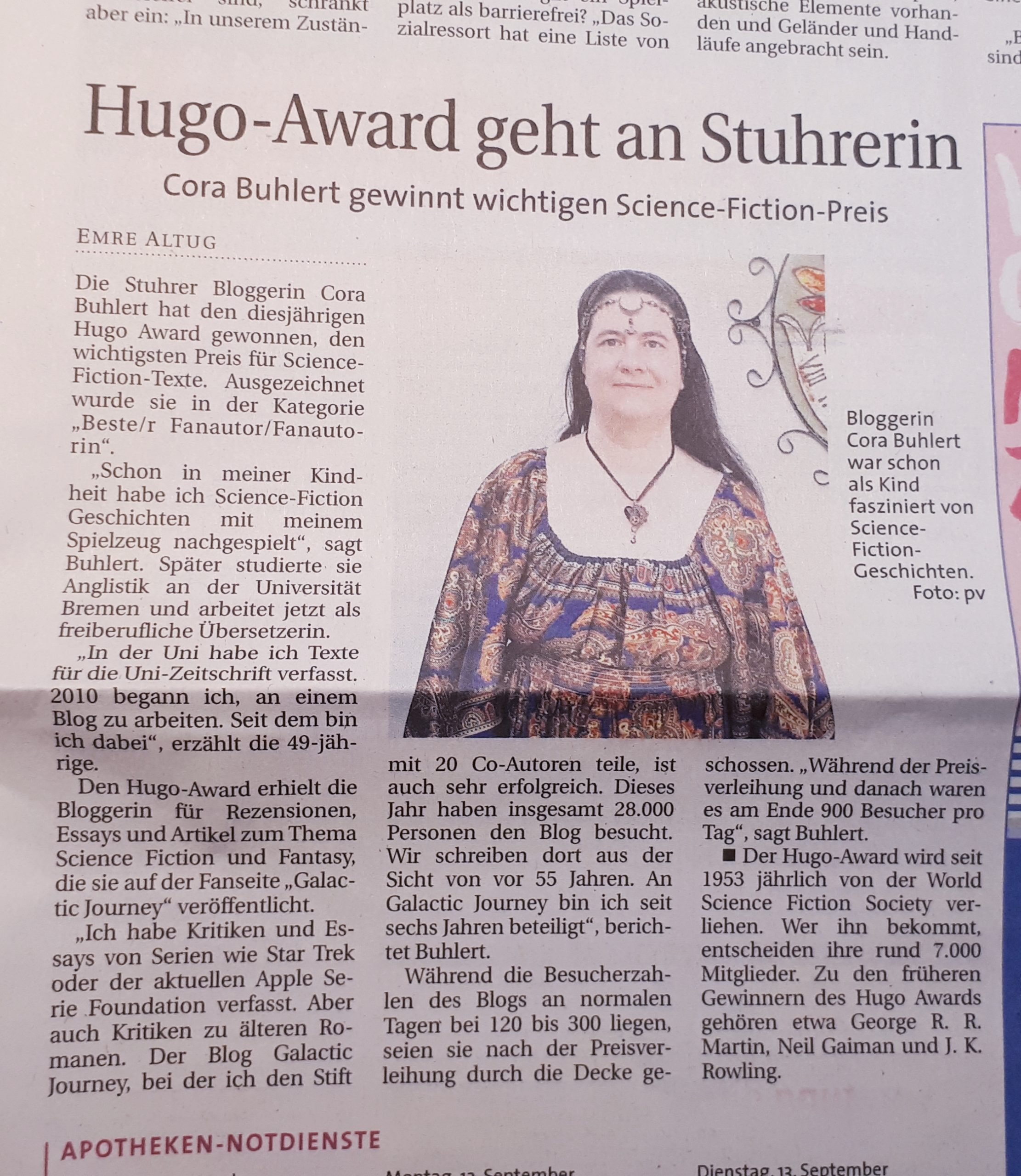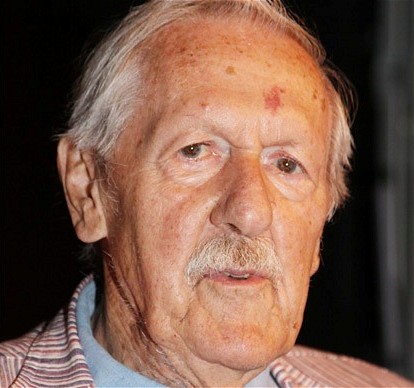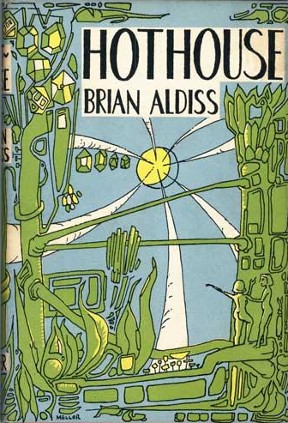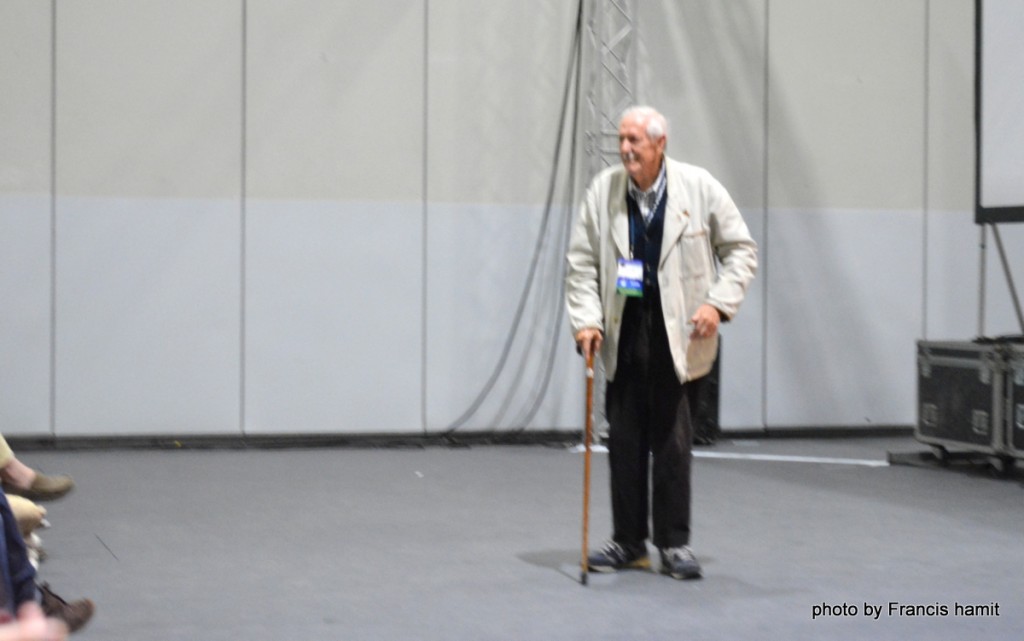(1) INVESTIGATIVE REPORTING AT ITS MOST. The news media covered the London Worldcon of 1957. They asked, “Do extraterrestrial things have much of a sex life?” Here’s a clip of the report:
ITN’s Lynne Reid Banks spoke to various creatures at the 15th World Science Fiction Convention, or Worldcon. Held in London, that year’s meet was dubbed “Loncon”. It was the first Worldcon to bring the global sci-fi community together outside the US.
Rob Hansen identified the fans in the video:
0.00 Jean Bogert with gun at start.
0.05 Guy with glasses looks like Sandy Sandfield
0.06 Norman Shorrock over shoulder of guy in mask
0.12 Eric Jones interviewed
0.25 Ron Buckmaster interviewed
0.50 Frank & Belle Dietz interviewed in alien costumes. Round-faced teenager in the background is Mike Moorcock.
1.18 Guy with moustache, right rear is Ken McIntyre
Postscript: Rob Hansen: “David Pringle has pointed out that the most famous writer in that video clip is actually the interviewer, Lynne Reid Banks, and that she’s still with us.”
(2) EMERGENCY BACKUP SCROLL TITLE. I thought it was too long for the headline because long titles are one suspected reason why subscriber notifications don’t generate. However, I rather like Daniel Dern’s suggestion:
Seventy-Six Tron Clones Led The Masquerade, With 104 Lady Thors Close Behind, Followed By Rows And Rows Of Freshly-Polished 3CPO’s…
(3) CHICON 8 FINAL COVID REPORT. The Chicon 8 committee sent a wrapup email to attending members reporting a final total of 60 people who voluntarily reported they tested positive for Covid during or shortly after the Worldcon.
(4) CORA BUHLERT IN THE PAPER. “I did get at least one of the local newspapers to bite and report about my Hugo win,” says Cora. “The article isn’t online, but I included a photo of the article itself and the front page, which mentions me.” In German, of course.


You can also see it in the online electronic edition. She’s on page 5: Aktuelle Ausgabe.
(5) GUARDIAN’S OPINION ON FANTASY. Strangely enough, the Guardian has taken an editorial position on J.R.R. Tolkien: “The Guardian view on Tolkien: much more than special effects”.
Back at the dawn of the new millennium, an Oxford don argued, at book length, that fantasy was the most important literature of the 20th century and that the claim rested on the work of JRR Tolkien. Prof Tom Shippey was duly ridiculed by some for his heresy, with this paper describing it as “a belligerently waterwalkerargued piece of fan-magazine polemic”. Among those who Prof Shippey cited as influenced by “the master” was one Alan Garner, author of a series of beloved children’s fantasies.
How much more secure the professor’s claims look today. Garner, now 87, has just been shortlisted for the Booker prize for a novel called Treacle Walker, which, if more folky than fantastic, certainly displays its fantasy pedigree. Meanwhile, Tolkien delivered more than 25 million global viewers to Amazon Prime on the first day of its splashy new prequel to The Lord of the Rings.
…Fantasy suits the era of film and television because it is infinitely grandiose while sidestepping the need to grapple with the effect on plot of modern technology: Frodo can’t phone home. However, two decades have passed since Jackson’s films landed, so the enduring popularity of The Lord of the Rings isn’t simply tie-in fever.
From the off, Tolkien was caught in the crossfire between those who dismissed his work as escapism and others who saw in it a moral purpose forged on the killing fields of the Somme. It’s a pointless binary. “Fantasy is escapist, and that is its glory,” wrote the master himself. “If we value the freedom of mind and soul, if we’re partisans of liberty, then it’s our plain duty to escape, and to take as many people with us as we can!”…
(6) A DIFFERENT PERSPECTIVE. Bobby Derie is not so accepting as the Guardian when he considers the racism in the fantasy written by two icons in “Deeper Cut: The Two Masters: H. P. Lovecraft, J. R. R. Tolkien, & Racism in Fantasy” at Deep Cuts in a Lovecraftian Vein.
… Lovecraft and Tolkien both held the image of the traditional English rural gentry as a kind of ideal.
Yet Lovecraft was no hobbit. While Lovecraft had an antiquarian yearning for old buildings and a rose-tinted vision of British Colonial period, his fiction was mostly set in the current day and focused on themes of degeneration, hoary survivals from the past, ancient aliens, and cults rather than a celebration or exultation of the small joys in life. While Lovcraft regretted what he called the coming “Machine Culture,” he did not ignore or decry the advancement of technology and industrialization, or exalt a rural state that had fallen into decay. Dunwich is no Shire, for all the rural trappings; it is kind of an anti-Shire, a place where old ways and habits have turned inward and strange….
(7) MAIL CALL. In another Deeper Cuts post, Bobby Derie looks at the letters exchanged between Robert E. Howard and Novalyne Price: “Her Letters To Robert E. Howard: Novalyne Price”
…Novalyne had been aware of Bob Howard through their mutual friends in Brownwood; she had dated Howard’s good friend Tevis Clyde Smith, and he had introduced the two in 1932. Like Robert E. Howard, she was interested in becoming a writer. Now that they were both in Cross Plains, the two renewed their acquaintance…and began what would be a tumultuous on-again, off-again romance. The two dated, argued, exchanged gifts, flirted, met each other’s families, went on long drives in the country, debated, criticized each other’s fiction, quarreled and made up and quarreled again…a story chronicled in her memoir One Who Walked Alone, later made into the motion picture The Whole Wide World….
(8) IT’S FINALLY LEAP YEAR AGAIN. The time has come – Quantum Leap premieres Monday, September 19 at 10/9c on NBC, streaming next day on Peacock. “Quantum Leap: Official Trailer”.
(9) SOON TO LAUNCH. Here’s an interview with Oliver Brackenbury of the forthcoming New Edge Sword and Sorcery Magazine. (Cora Buhlert will have an essay in its first issue.) “Editor Spotlight: Interview with Oliver Brackenbury of New Edge Sword and Sorcery Magazine” at Deep Cuts in a Lovecraftian Vein.
In your guest post on Scott Oden’s blog discussing New Edge as a mode or evolution of Sword & Sorcery fiction, you emphasize “inclusivity.” What does that mean in the context of the stories and writers you’re looking to publish?
OB: What inclusivity means to me is making sure that people outside my own demographic—white, cishet, neurotypical, able-bodied males, or just “white guys” as, for the sake of brevity, I’ll use going forward—can see themselves in both the stories and the authors creating them, ideally making them feel welcome within the community. This is key for expanding the audience of our beloved fantasy sub-genre, as well as its pool of authors.
I’ve gained firsthand experience with this in my six years volunteering with a group dedicated to promoting the western Hemisphere’s largest publicly accessible speculative fiction genre archive—The Merril Collection. Through no malice of anyone involved, in the time I’ve been with them, our group has been made up almost or entirely of white people. Our selling old paperbacks to help raise funds would often combine with 20th century publishing trends to create the scene of a couple of white people sitting behind event tables coated in covers featuring white characters written by white authors, trying to encourage the full breadth of humanity to spend a few dollars in support of the collection, while hearing our pitch for it.
All that sameness was a significant obstacle to achieving our goals, as more than one non-white individual made clear when—quite reasonably—saying “I only see white faces here.” or “I don’t see myself in what you are doing.”
Even coming back to myself, I don’t hate my fellow white guys any more than I hate IPAs, but I get frustrated when the vast majority of shelf space is filled with the same thing, whether it’s beer or writerly perspectives. All of this has informed the approach I’m taking with the stories and authors I’m looking to publish.
(10) MEMORY LANE.
1964 – [By Cat Eldridge.] Ok, I confess. I really, really loved the original Mary Poppins which came out fifty-eight years ago. No I didn’t see it until (I think) a decade or so later but I immediately loved it.
Mike Glyer notes that “She doesn’t only fly. At least in the 1964 movie she has a suitcase that must be related to the TARDIS, all the stuff she pulls out of it. And her boyfriend has the ‘luck’ superpower!”
It was directed by Robert Stevenson from the screenplay by Bill Walsh and Don DaGradi as based off P. L. Travers’s Mary Poppins series. It was produced by Walt Disney and starred Julie Andrews in her first acting role. Principal other cast were Dick Van Dyke, David Tomlinson and Glynis Johns. The film was shot entirely at the Walt Disney Studios in Burbank, California, using painted London background scenes.
It won’t surprise you that the film received universal acclaim from film critics, and that Julie Andrews and Dick Van Dyke got lavish praise. Box office wise, it earned some forty-five million dollars on an estimated budget of four or so million dollars (Disney never released the budget officially, something they do quite often) and it’s had at least another hundred million in box office rentals since then. Not to mention DVD and such sales.
It was the only one of his films which earned Disney a Best Picture nomination during his lifetime.
In 2013, the film was selected for preservation in the United States National Film Registry by the Library of Congress as being culturally, historically, or aesthetically significant.
A biographical drama on the making of the film, Saving Mr. Banks, was released nine years ago. It was well received with The Hollywood Reporter saying the film was an “affecting if somewhat soft-soaped comedy drama, elevated by excellent performances.”
But that’s not where this story ends. As Charles de Lint once said, “There are no happy endings… There are no endings, happy or otherwise. We all have our own stories which are just part of the one Story that binds both this world and Faerie. Sometimes we step into each others’ stories – perhaps just for a few minutes, perhaps for years – and then we step out of them again. But all the while, the Story just goes on.” And so it is with the Mary Poppins story.
Did I mention that P.L.Travers loathed this film with all her heart save Andrews as Poppins? Well she really did. Which complicated making a sequel. When Disney personally went to her a year later seeking rights to a sequel, she rejected it vehemently. Twenty years on did not at all mellow her, so she rejected them yet again save Andrews playing Poppins. And the use of the color red. Don’t ask.
With approval from Travers’ estate (see death helps clear rights as does offering presumably offering up the estate large sums of money), Disney greenlit the project with the film taking place twenty-five years after the first one was set and having a stand alone narrative that was based on the remaining seven books in the series.
That sequel, Mary Poppins Returns, was released four years ago. It was well received too. Dick Van Dyke, a cast member of the original film, appears in the film as Mr. Dawes Jr., a role originated by Arthur Malet in the previous film.
And Angela Lansbury is the Balloon Lady. The part was written as a cameo role for Julie Andrews who portrayed Mary Poppins in the original film, but she turned the role down as she felt her presence would unfairly take attention away from Emily Blunt who plays Mary Poppins here.

(11) TODAY’S BIRTHDAYS.
[Compiled by Cat Eldridge.]
- Born September 11, 1856 — Richard Ganthony. OK, this is going to a little bit explaining. Imagine that an author decided to riff off Charles Dickens’ A Christmas Carol. With Martians. Seriously. A Message from Mars is a play primarily written by him, first performed at London’s Avenue Theatre in November 1899. The play is about Horace Parker, a Grinch-like man. Horace refuses go with Minnie, his fiancé, to a ball because he wants to stay home reading about new discoveries about the planet Mars. He falls asleep and dreams that he is visited by a Messenger from Mars. The Messenger trys to cure Horace of his selfishness. After a series of visions, the Messenger in the last Visio has him as a beggar in rags. Having realized the error of his ways, he awakens a changed man. It was filmed twice, both times as A Message from Mars (1913 and 1921, and I’m assuming as silent movies given their dates). It would be novelized by Lester Lurgan. (Died 1924)
- Born September 11, 1929 — Björn Nyberg. A Swedish writer known largely for his Conan stories which given that he wrote just one non-Conan story makes sense. His first book in the series was The Return of Conan which was revised for publication by L. Sprague de Camp. Likewise, they later did Conan the Avenger, Conan the Victorious, Conan the Swordsman and Sagas of Conan. The latter two are available on iBooks and Kindle. (Died 2004.)
- Born September 11, 1928 — Earl Holliman, 94. He’s in the cook in Forbidden Planet and he shares a scene with Robbie the Robot. A few short years later, he’s Conrad in Visit to a Small Planet though it’ll be nearly fifteen before his next genre role as Harry Donner in the Six Million Dollar Man’s Wine, Women and War TV film. He shows up as Frank Domino in the Night Man series, an adaptation of a Malibu Comics’ Ultraverse character. What the Frell is that publisher?!? Surprisingly he’s done no other genre series beyond being in the original Twilight Zone series premiere as Mick Ferris in the “Where Is Everybody?” episode.
- Born September 11, 1930 — Jean-Claude Forest. Forest became famous when he created Barbarella, which was originally published in France in V Magazine in 1962. In 1967 it was adapted by Terry Southern and Roger Vadim and made into 1968 film of that name with Jane Fonda in the lead role, with him acting as design consultant. It was considered an adult comic by the standards of the time. An animated Barbarella series was booted around in the Sixties but never made. (Died 1998.)
- Born September 11, 1941 — Kirby McCauley. Literary agent and editor, who as the former represented authors such as Stephen King, George R.R. Martin and Roger Zelazny. And McCauley chaired the first World Fantasy Convention, an event he conceived with T. E. D. Klein and several others. As Editor, his works include Night Chills: Stories of Suspense, Frights, Frights 2, and Night Chills. (Died 2014.)
- Born September 11, 1965 — Catriona (Cat) Sparks, 57. Winner of an astounding eighteen Ditmar Awards for writing, editing and artwork, her most recent in 2021 for her Dark Harvest story collection. She won two in the same year in 2014 when her short story “Scarp” was awarded a Ditmar for Best Short Story and The Bride Price a Ditmar for Best Collected Work. She has just one novel to date, Lotus Blue, but has an amazing amount of short stories which are quite stellar. Lotus Blue and The Bride Price are both available on the usual suspects.
- Born September 11, 1970 — Colson Whitehead, 52. Winner of the Arthur Clarke C. Award for The Underground Railroad. Genre wise, he’s not a prolific writer, he’s written but two other such works, The Intuitionists and Zone One. He’s written but one piece of short genre fiction, “The Wooden Mallet”. However he’s written seven other works including John Henry Days which is a really interesting look at that legend, mostly set at a contemporary festival about that legend.
(12) COMICS SECTION.
- Popeye vs Credential. Guess who wins?
- Crankshaft has a crossover from the Hi and Lois strip.
(13) WHEN CONAN RESCUED TED WHITE. Brian Murphy celebrated the magazine Fantastic and its contribution to the sword and sorcery boom of the 1960s and 1970s: “A Fantastic Chapter for Conan and Sword-and-Sorcery” at DMR Books.
The late 1960s and early ‘70s were peak sword-and-sorcery. The Lancer Conan Saga was at its zenith of popularity, eventually selling by some estimates upwards of 10 million copies. Fritz Leiber and Michael Moorcock were seeing broad mass market paperback publication, Leiber with Swords and Deviltry and Swords Against Death (Ace, 1970) and Moorcock with the likes of the first Corum trilogy (Berkley Medallion, 1971). And as the ‘60s gave way to the ‘70s a struggling magazine was about to get a signal boost from S&S’s mightiest hero.
As Ted White found out during his tenure as editor of the digest-sized Fantastic Science Fiction & Fantasy Stories/Fantastic Science-Fiction/Fantastic Stories of Imagination, best known as Fantastic, the public appetite for Conan ran deep, and was not slaked by the Lancers.…
Circulation remained flat, but White finally got the boost he was looking for when he began publishing stories of S&S’ mightiest hero: Conan, black-haired, sullen-eyed, sword in hand, a thief, a reaver, a slayer, with gigantic melancholies and gigantic mirth, was about to tread the digest size pages of Fantastic under his sandalled feet, in the form of four new stories by Lin Carter and L. Sprague de Camp….
(14) FAKE NEWS. The New York Times recounts how “Galileo Forgery’s Trail Leads to Web of Mistresses and Manuscripts”.
When the University of Michigan Library announced last month that one of its most prized possessions, a manuscript said to have been written by Galileo around 1610, was in fact a 20th-century fake, it brought renewed attention to the checkered, colorful career of the man named as the likely culprit: Tobia Nicotra, a notorious forger from Milan.
Nicotra hoodwinked the U.S. Library of Congress into buying a fake Mozart manuscript in 1928. He wrote an early biography of the conductor Arturo Toscanini that became better known for its fictions than its facts. He traveled under the name of another famous conductor who had recently died. And in 1934 he was convicted of forgery in Milan after the police were tipped off by Toscanini’s son Walter, who had bought a fake Mozart from him.
His explanation of what had motivated his many forgeries, which were said to number in the hundreds, was somewhat unusual, at least according to an account of his trial that appeared in The American Weekly, a Hearst publication, in early 1935.
“I did it,” the article quoted him as saying, “to support my seven loves.”
When the police raided Nicotra’s apartment in Milan, several news outlets reported, they found a virtual forgery factory, strewn with counterfeit documents that appeared to bear the signatures of Columbus, Mozart, Leonardo da Vinci, George Washington, the Marquis de Lafayette, Martin Luther, Warren G. Harding and other famous figures.
Investigators had also found a sort of shrine to his seven mistresses, at least according to The American Weekly. …
(15) POSTSCRIPT FOR PAT CADIGAN’S 9/10 BIRTHDAY. [Item by John Hertz.] When she was Toastmaster at MidAmericon II, I contributed this (acrostic, in 5-7-5-syllable lines) to the newsletter.
Passing all measure,
Ardent, courageous, comic,
Taking each moment
(16) PURE COMMERCIAL IMAGINATION. Mashed gives its pitch for “Discontinued Wonka Candy That Needs To Make A Comeback”.
Unfortunately, fans of the fictional-turned-reality candy empire had been watching supplies dwindle over the decades, and the vast majority of Wonka candies have been discontinued as of 2022. In fact, the Wonka brand itself was eventually retired after being acquired by Nestlé in 1988, according to The Christian Science Monitor. The Wonka brand was sold off in 2018, and the remaining candies found a new home with Ferrero (via The Motley Fool).
Surprising, Wonka Candy isn’t entirely extinct.
… While many Wonka candies have completely vanished from store shelves, others can still be found if you know where and what to look for. Back in the days of the Willy Wonka Candy Company, Kazoozles offered a different flavor profile than the iconic chocolate bars. The Twizzler-like sweets had a tart fruity taste starting with the original cherry punch flavor, according to Snack History. In 2015 when the Wonka brand was acquired by Nestlé, Kazoozles was rebranded and re-released under the now-familiar SweeTARTS Ropes candy….
(17) DINOMUMMY. “Quick-dried Lystrosaurus ‘mummy’ holds clues to mass death in the Triassic” – Nature explains the research.

The fossilized skin of young mammal-like reptiles hints that drought led to their demise some 250 million years ago, at the start of the Triassic period1.
A few millennia before their deaths, climate change thought to be caused by volcanic eruptions led to the Permian extinction, the largest mass-extinction event in Earth’s history. Among the small number of animals to survive the cataclysm were reptiles in the genus Lystrosaurus.
While looking for clues to what the climate was like after the mass extinction, Roger Smith at the University of the Witwatersrand in Johannesburg, South Africa, and his colleagues uncovered the remains of 170 four-limbed animals in South Africa’s Karoo Basin. Among the tangled remains, the researchers found young Lystrosaurus of two species that had died in clusters around what was once a dry riverbed.
Several of the younglings were in a spreadeagled position seen in some animals when they collapse from heat exhaustion. Two of the fossils also had what appeared to be mummified skin, which probably formed through rapid drying after death.
Together, this evidence points to a mass die-off of young Lystrosaurus owing to heat and water shortages, suggesting that the climate after the Permian extinction underwent periods of drought.
Primary research here.
(18) DAN DARE. [Item by Martin Morse Wooster.] The BCC posted this clip in which Patrick Stenson interviews Dan Dare creator Frank Hampson in this clip from 1975.
(19) HE ISN’T SPOCK. (OKAY, HE LIED). [Item by Martin Morse Wooster.] Leonard Nimoy chats with the BBC’s Terry Wogan in January 1989 about his autobiography I Am Not Spock, how he became a director, and how in classic Star Trek he was so “emotional” “it was like doing Mutiny On The Bounty” in this clip which dropped yesterday.
[Thanks to John King Tarpinian, Andrew Porter, Chris Barkley, Rob Thornton, Ersatz Culture, Cora Buhlert, Steven French, John Hertz, Daniel Dern, SF Concatenation’s Jonathan Cowie, Michael Toman, Cat Eldridge, Mike Kennedy, Martin Morse Wooster, and JJ for some of these stories. Title credit belongs to File 770 contributing editor of the day John A Arkansawyer.]




